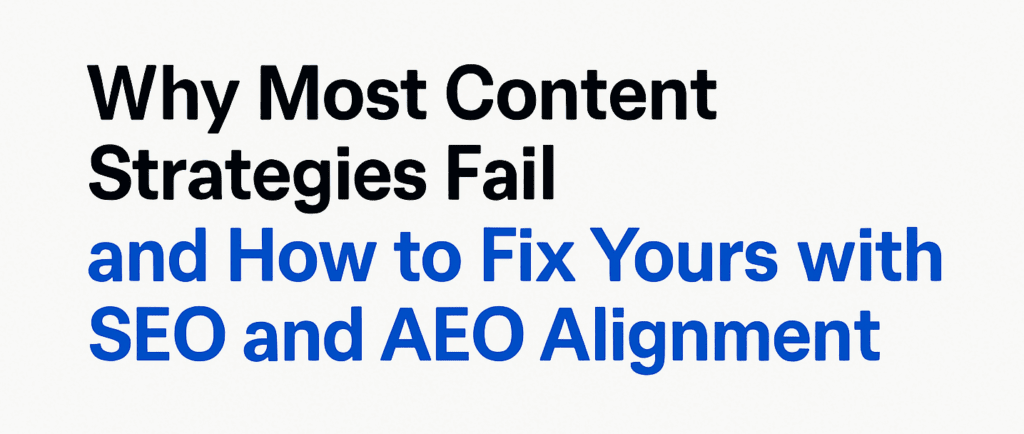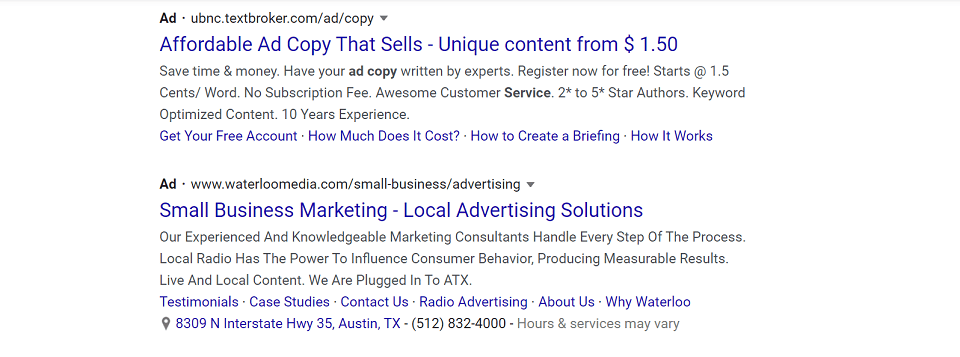Most businesses treat content strategy like a checklist:
✅ Blog posts?
✅ Social shares?
✅ Some SEO sprinkled on top?
Then the traffic underperforms.
Leads stay flat.
ROI is murky.
And teams start questioning whether content marketing is worth the effort.
Here’s the hard truth: most content strategies fail because they are disconnected from how people actually discover and consume information today.
If you aren’t aligning your content with both search engine optimization (SEO) and answer engine optimization (AEO) / generative engine optimization (GEO), you are building in the dark.
Let’s break down why traditional content strategies fall short.
AND, how to fix yours for long-term discoverability, visibility, and business impact.
The Problem: Strategy That Starts from the Wrong Place
Most content strategies begin in one of three ways:
- An editorial calendar based on what leadership wants to promote
- A series of ideas from product marketing or sales enablement
- A push for thought leadership, written without supporting data
The common thread is that these approaches focus on what the business wants to say.
But what about what the target audience is searching for or how they are searching?
Even when keyword research is involved, it is often disconnected from the rest of the process.
Writers treat keywords like required ingredients.
SEO teams only get to optimize after drafts are already written.
Product teams push positioning that overrides natural, user-friendly messaging.
This kind of fragmented process leads to content that:
- Ranks for irrelevant or low-intent terms
- Fails to appear in AI-driven summaries or answer boxes
- Misses the mark on buyer intent
- Performs poorly in organic search and tools like ChatGPT, Perplexity, or Gemini
Search Has Changed. Content Strategy Has Not.
Google isn’t just returning a list of blue links anymore.
Answer engines, AI-powered summaries, and featured snippets take up prime real estate.
And user behavior has shifted.
Searches are more conversational, more specific, and more impatient.
If your content strategy still revolves around SEO tactics from 2018, it is outdated.
SEO is no longer about ranking number one.
It is about being selected as the best possible answer across multiple search and AI platforms.
That includes:
- Traditional organic search
- Featured snippets and People Also Ask
- AI-generated summaries in search engines
- Answer tools like ChatGPT, Perplexity, and Gemini
- Voice search and assistant interfaces
This is where AEO comes in. Answer Engine Optimization is not a buzzword.
It is the evolution of SEO, in a world where AI based search features extract, summarize, and deliver it.
All BEFORE a click ever happens.
And that doesn’t account for Generative Engine Optimization (GEO), which gets your content shown on AI platforms like ChatGPT and Gemini.
The Fix: Build Your Strategy Around SEO, AEO, and GEO Together
To compete today, your strategy must support three types of discoverability:
- SEO: how Google crawls, indexes, and ranks your site
- AEO: how search engines and AI systems extract, summarize, and cite your content as an authoritative answer
- GEO: how large language models like ChatGPT, Claude, and Gemini use your content to generate responses
Here’s how to align these layers within your content strategy.
Step 1: Start With Search Intent and Real Questions
Every content initiative should begin with a clear understanding of user intent.
Begin by asking yourself:
- What is the user trying to achieve?
- What are they asking?
- Where are they in the decision process?
Use tools like:
- Google Search Console for query data
- People Also Ask and Related Searches
- ChatGPT and Perplexity to see how AI responds to key questions in your field
- Your website’s internal search data
The takeaway: keywords are less important than they once were. Questions matter more.
Optimize for well-formed, helpful questions. This will give you a better shot at visibility in both Google and AI-generated answers.
Step 2: Create Structured, Scannable, High-Value Content
Content that performs across SEO, AEO and GEO must be:
- Clear and well-organized
- Easy to skim
- Marked up with headings, bullets, and schema
- Precise in answering the searcher’s question
- Authoritative without being long-winded
Tactical recommendations:
- Use H2 and H3 headers to organize ideas
- Include TLDR summaries and pull-out takeaways
- Add FAQs that directly answer user questions
- Keep sections tight and digestible
- Target featured snippets with structured definitions
Also, use schema markup where appropriate.
For example, FAQ, HowTo, and Article schema help AI systems understand your page faster and with better context.
Few teams do this well. But it can give you a real edge with both search and AI tools.
Step 3: Build Around Topical Authority, Not Just Keywords
Google and AI models favor depth and subject matter coverage.
One article focused on a keyword does not establish authority.
But a full cluster of related content, structured around a main topic, tells search engines and LLMs that your brand knows the subject.
To build topical authority:
- Define your key content pillars
- Build supporting content for each one
- Interlink all posts in the cluster
- Use internal linking and consistent terminology
- Keep content up to date
This is how you build long-term visibility.
Not just for SEO, but also within LLMs that are indexing your site for training or real-time citation.
Step 4: Align Across Teams Early
Content strategy fails when functions operate in silos.
SEO teams focus on rankings.
Writers focus on tone and messaging.
Product marketing pushes brand stories.
Analytics teams report on clicks after the fact.
The solution? Upfront alignment.
Unify your workflows:
- Share editorial calendars across SEO, content, and product teams
- Agree on goals before starting content drafts
- Build templates that support both brand voice and discoverability
- Set up post-publishing reviews across functions
Make sure that every team understands the strategic goal behind each piece. Prior to execution.
This includes whether it is targeting organic search, AI retrieval, lead generation, or awareness.
Step 5: Monitor Where You Appear, Not Just How You Rank
Traditional KPIs like keyword rankings, organic sessions, and backlinks are still useful.
But they don’t tell the whole story.
Today’s reporting should also track:
- Whether your content appears in AI-generated summaries
- How often tools like ChatGPT or Perplexity cite your brand
- Presence in Google’s AI Overviews (if active in your region)
- Featured Snippet and People Also Ask placements
- Voice search results
These metrics show your real reach across all modern discovery tools.
They also help you identify content that AI systems are extracting and reusing, even if it is failing to produce clicks.
Final Thoughts: Content Strategy Needs to Evolve
Content marketing still works.
But only when you ground it in how people discover content today.
The winning strategies in 2025 and beyond will:
- Start with user intent, not internal opinion
- Treat SEO, AEO, and GEO as core pillars from day one
- Break down silos across teams
- Focus on structure, clarity, and authority
- Monitor results beyond traditional analytics
If your content isn’t showing up where people search and ask questions, it isn’t working.
To fix your strategy, start with asking better questions and designing content to answer them.
Want help evaluating where your content stands today?
Reach out to schedule a content discoverability audit that blends SEO, AEO, GEO, and actionable strategy.
Tommy Landry
Latest posts by Tommy Landry (see all)
- B2B SEO in 2025: Winning Visibility in AI-Curated Buyer Journeys - December 16, 2025
- Local SEO Meets AEO and GEO: How AI Platforms Read Local Authority Signals - December 9, 2025
- What Is an SEO Proposal and What Should It Include? - December 2, 2025





